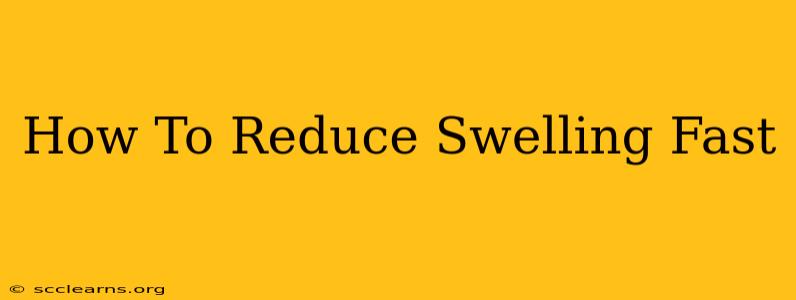Swelling, or edema, can be a frustrating and sometimes painful experience. It occurs when excess fluid builds up in your body's tissues. While swelling can be a symptom of various conditions, ranging from minor injuries to serious illnesses, there are several ways to reduce swelling quickly and effectively. This guide explores both home remedies and medical interventions to help you find relief.
Understanding the Causes of Swelling
Before diving into treatments, it's crucial to understand why you're experiencing swelling. Common causes include:
- Injury: Sprains, strains, fractures, and other traumas can cause localized swelling due to inflammation.
- Infection: Infections can trigger swelling as your body fights off the invading pathogens.
- Allergic Reactions: Allergies to food, medications, or insect bites can result in significant swelling.
- Medical Conditions: Certain conditions like heart failure, kidney disease, liver disease, and venous insufficiency can contribute to widespread swelling.
- Medication Side Effects: Some medications, including certain blood pressure drugs and hormone therapies, can cause swelling as a side effect.
- Pregnancy: Fluid retention is common during pregnancy, often leading to swelling in the hands, feet, and ankles.
- Premenstrual Syndrome (PMS): Hormonal fluctuations before menstruation can also cause fluid retention and swelling.
Fast Ways to Reduce Swelling at Home
If your swelling is mild and you suspect a minor cause, these home remedies might provide quick relief:
1. Elevation:
Raising the swollen area above your heart helps gravity drain excess fluid. This is particularly effective for swelling in the legs, ankles, and feet. Pro-tip: Elevate for at least 30 minutes several times a day.
2. Compression:
Applying gentle compression with a bandage or elastic support stocking can help reduce swelling by limiting fluid accumulation. Caution: Don't wrap too tightly, as this can restrict blood flow.
3. Rest:
Avoid strenuous activity that might worsen the swelling. Allowing the affected area to rest gives your body time to heal and reduce inflammation.
4. Ice Packs:
Applying cold compresses (ice packs wrapped in a thin cloth) for 15-20 minutes at a time can help numb the pain and reduce inflammation. Important: Never apply ice directly to the skin.
5. Over-the-Counter Pain Relief:
Nonsteroidal anti-inflammatory drugs (NSAIDs) like ibuprofen or naproxen can help reduce both pain and inflammation. Always follow the recommended dosage instructions.
6. Hydration:
While it seems counterintuitive, staying well-hydrated can actually help flush out excess fluid from your system. Drink plenty of water throughout the day.
When to Seek Medical Attention
While home remedies can be effective for mild swelling, you should seek medical attention if:
- Swelling is severe or sudden.
- Swelling is accompanied by fever, chills, or pain.
- Swelling is accompanied by shortness of breath or chest pain.
- Swelling doesn't improve after a few days of home treatment.
- You have a known medical condition that might be causing the swelling.
- The swelling is accompanied by redness, warmth, or tenderness.
Your doctor can diagnose the underlying cause of your swelling and recommend appropriate treatment. This might involve medication, physical therapy, or other interventions.
Preventing Swelling
Preventing swelling involves addressing underlying causes and adopting healthy lifestyle habits:
- Maintain a healthy weight.
- Regular exercise.
- Avoid prolonged sitting or standing.
- Elevate your legs when sitting or sleeping.
- Wear supportive footwear.
- Manage underlying medical conditions.
- Eat a balanced diet low in sodium.
Reducing swelling effectively depends on understanding its cause. By combining home remedies with timely medical attention when necessary, you can find relief and improve your overall well-being. Remember, this information is for general knowledge and does not substitute professional medical advice. Always consult your doctor for any health concerns.

